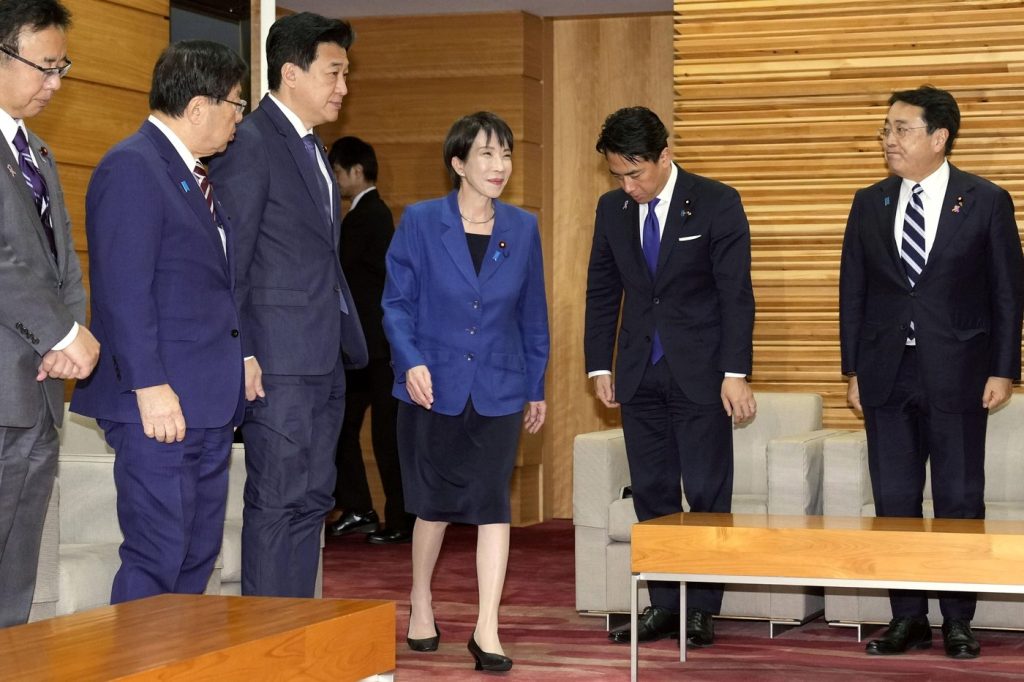TOKYO (AP) — Japan's Cabinet has approved a significant 21.3 trillion yen ($135.4 billion) stimulus package aimed at revitalizing the economy through expansionary government spending and alleviating the financial burden of rising prices on consumers. This decision comes shortly after Prime Minister Sanae Takaichi took office, during which she pledged to increase government expenditures despite concerns that such actions could further delay the efforts to reduce Japan's national debt, which is currently estimated to be approximately three times the size of its economy.
In remarks to the media, Takaichi emphasized that the newly approved package is designed to promptly fulfill her promises to the Japanese public. She stated, “Through wise spending, we will change worries into hope and achieve a strong economy.” The Prime Minister expressed the necessity of bolstering national strength through expansionary measures while avoiding the adverse effects associated with excessively contractionary policies.
The latest spending initiative greatly surpasses pre-COVID-19 pandemic expenditure levels and is also intended to mitigate the effects of increased U.S. tariffs on Japanese exports. Under former President Donald Trump's administration, Japan's exports to the U.S. have hit a rough patch, with a reported decline in October marking the seventh consecutive month of falling shipment numbers. In contrast, exports to other global markets, particularly within Asia, have increased by 3.7%.
In recent trading, Japanese government bonds saw a sell-off by investors, resulting in rising yields, while the yen has depreciated to nearly its lowest point this year. Compounding economic pressures, share prices have also dipped, partly due to rising tensions with China following comments made by Takaichi that upset Beijing. This geopolitical friction has led to retaliatory actions from China, including advisories warning Chinese tourists and students against visiting Japan. The benchmark Nikkei 225 index reflected this downtrend, falling by 2.4%, with technology shares experiencing heavy selling.
The extensive stimulus package approved by the Cabinet includes various subsidies aimed at alleviating energy costs, reductions in gasoline tax, and other measures to support consumers facing the rising cost of living. According to government reports, core inflation, which excludes volatile food prices, was reported at 3% in October, exceeding the central bank’s inflation target of about 2%.
Specific financial measures outlined in the package involve one-time cash handouts of 20,000 yen (approximately $130) per child, requiring around 400 billion yen ($2.6 billion) in government funding, along with the distribution of rice vouchers or other coupons worth 3,000 yen (about $20) for each individual, distributed by local authorities.
For Takaichi’s government to implement this comprehensive spending package, they must compile a supplementary budget and secure parliamentary approval by the year's end. This process presents a substantial challenge for her ruling coalition, which currently lacks a majority in both the Upper and Lower houses of the Diet. Takaichi succeeded former Prime Minister Shigeru Ishiba, whose administration was criticized for a slow response to rising prices and stagnant wages, leading to his ousting from power.
As Japan’s first female Prime Minister, Takaichi currently enjoys considerable public support, largely driven by expectations for reform within Japan's aging political landscape. However, her minority government's success in passing the supplementary budget and the stimulus package will depend heavily on cooperation with opposition parties.
Critics, including opposition lawmakers and economic experts, have raised questions about the effectiveness of the proposed stimulus package in achieving its goals. One of the key objectives is to slightly lower consumer prices through energy cost reductions, although it is anticipated that any positive impact on inflation may be temporary, as increased demand spurred by the stimulus could counterbalance these efforts and drive prices higher.
The Cabinet Office has estimated that the stimulus package is expected to boost Japan's gross domestic product by 24 trillion yen ($155 billion), translating to an annualized growth rate of 1.4%. Japan’s economy, currently the world’s fourth largest, contracted at an annual rate of 1.8% during the July-September period.










